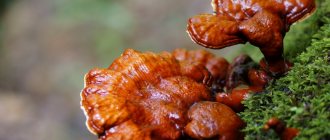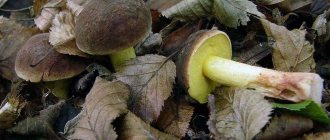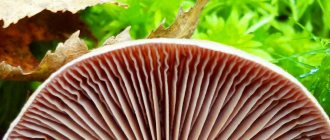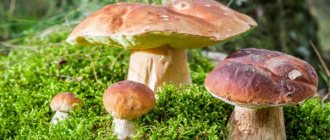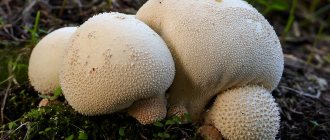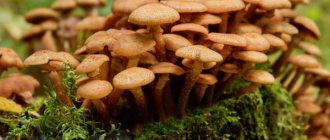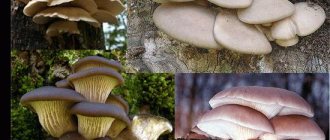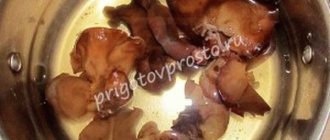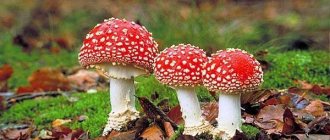General signs
- Relationship between hymenophore and cap
. In most boletus mushrooms, the tubular layer is easily separated from the flesh of the cap, while the lamellar hymenophore is usually firmly connected to the cap. There are relatively small groups of agaric fungi (for example, the Svinushkov family) with a weakly attached hymenophore. This sign is easy to identify if you cut the edge of the cap: a small gap will appear on the cut, allowing you to separate the hymenophore from the pulp. - Color
. Mushrooms are often divided into two large groups: those with light-colored and those with dark hymenophores. The color of the hymenophore can change greatly with age, so reference books always provide a description of this change. For a more accurate determination, use the color of the spore powder, which does not always coincide with the color of the hymenophore. - Relationship between the hymenophore and the stalk
.
Descending
- the hymenophore moves from the cap to the stalk, sometimes descending to its lower part. - Adherent
- the hymenophore grows to the stalk, but does not descend along it. - Free
- has no contact with the surface of the leg.
For an overgrown hymenophore, there are several more options: wide-grown
,
narrowly adherent
, with
a notch
or
tooth
near the stem.
It is convenient to study the nature of the attachment of the hymenophore to the stalk on a fruiting body cut along the axial line.
Types of hymenophores
Useful properties and contraindications
You may be interested in: How do edible talkers differ from false mushrooms? How many days after rain do mushrooms grow? Bitter mushroom: photo and detailed description
Polypore has a whole range of medicinal properties. Thus, it is widely used as a hemostatic agent. If the mushroom is washed well and applied to the wound, its pores will absorb blood and create a kind of protective layer on the surface of the damaged area. In this case, the tinder fungus acts as a plant “bandage”.
In addition, tinder:
- fights depressive disorders;
- has antibacterial and antiviral effects;
- restores liver cells;
- normalizes metabolism;
- cleanses the body of toxins and carcinogens;
- promotes the healing of wounds and other skin lesions.
Curious!
A rather interesting feature of this mushroom is that it is used not only for medicinal purposes. It is also used in everyday life as a water filter. The dense structure of the fruit is capable of retaining all the impurities and salts that are present in tap liquid. Thus, using such a filter, you can obtain clean water that is suitable for consumption in its raw form.
The harm of an inedible fruit is that it can cause allergic reactions, as well as intoxication of the body. Therefore, it is strictly prohibited for use by allergy sufferers, pregnant women, children, and nursing mothers.
Smooth
The smooth hymenophore is the simplest; it does not have a developed surface. This type is most often found in ascomycetes and is found on the upper surface of the cup-shaped apothecia or on the outer surface of the “caps” of morels.
In addition to ascomycetes, it also occurs in other fungi with club-shaped, coral-shaped fruiting bodies and in some species of the family Cantharellaceae
(gray funnelwort).
True tinder fungus (Fomes fomentarius)
Taxonomy:
- Division: Basidiomycota (Basidiomycetes)
- Subdivision: Agaricomycotina (Agaricomycetes)
- Class: Agaricomycetes (Agaricomycetes)
- Subclass: Incertae sedis (indefinite position)
- Order: Polyporales
- Family: Polyporaceae
- Genus: Fomes (Tinder fungus)
- Species: Fomes fomentarius (True polypore)
Synonyms:
- Blood sponge;
- Polyporus fomentarius;
- Boletus fomentarius;
- Ungulina fomentaria;
- Fomes griseus.
True tinder fungus (Fomes fomentarius) is a mushroom from the Coriolidae family, belonging to the genus Fomes. Saprophyte, belongs to the class Agaricomycetes, category Polyporous. Widely distributed.
folded
This type has a surface in the form of radial folds or randomly located wrinkles. It is found mainly in club-shaped and prostrate fruiting bodies, but is also characteristic of some cap-shaped ones. Fungi of some families ( Paxillaceae
,
Cantharellaceae
) have a folded hymenophore, outwardly strongly reminiscent of a lamellar one, such mushrooms are often described as lamellar.
Spiky
The spiny hymenophore occurs in prostrate, bushy and cap-peduncle fruiting bodies. Consists of conical or needle-shaped spines, usually located on the lower surface of the mushroom. It is especially characteristic of the families Hydnaceae and Bankeraceae, but is also found in others (for example, in the common auriscalpium mushroom growing on fallen pine cones and in the false blackberry gelatinous).
Tubular
A tubular or porous layer is found in boletaceae and polypores. It is always located on the lower surface of the cap or sessile fruiting body, and is a mass of tubes that open downwards. Almost always, the tubes form a solid mass, but in one mushroom - the liverwort - the tubes do not grow together with side walls and can be easily separated from each other.
An important defining feature is the pore size
.
The reference books indicate the size of one pore or the number of pores per 1 millimeter of the surface of the hymenophore. Another important feature is shape
: pores can be regular, round or angular.
The color
of the porous surface (i.e., the pores themselves, or the openings of the tubes) may differ from the color of the tubular mass; this is clearly visible in the section of the hymenophore.
Is it possible to grow mushrooms at home?
For medicinal purposes, this type of tinder fungus can be grown at home. For this purpose, either a substrate or a stump is used.
Growing on substrate
Nutritious soil for tinder fungus can be made from:
- sawdust;
- shavings;
- bark separated from small branches.
Mix all these components together, then:
- Pour boiling water over the substrate.
- When the temperature of the mixture drops to room temperature, the remaining liquid must be drained and the resulting mass must be combined with the mycelium.
- Spread the soil into polyethylene bags.
- Place the mycelium bags in a cool, damp place. The humidity level should not be below 80%.
You need to make holes in the bags. The most optimal air temperature is +20 degrees. Lighting should be natural. The first fruits can be harvested in 30-40 days.
Use of stumps
If you don’t have the desire or time to prepare the substrate, you can use wooden beams or stumps. Planting of tinder fungi in this case is carried out according to the following algorithm:
- Soak the wood well in water until it becomes soft.
- Make as many cuts in the bark as there should be mushrooms. Holes can be cut, sawed or drilled.
- Place the mycelium into the holes made.
- Place the beams or stumps in a dark place, cover with leaves.
labyrinthine
This type of spore-bearing layer is a modification of a tubular layer with pores elongated in the radial direction and the walls of the tubes missing in some places. Sometimes the tubes are so deformed that in appearance such a surface becomes similar to a lamellar or folded hymenophore. Found in polypore fungi (family Fomitopsidaceae
,
Coriolaceae
) with sessile fruiting bodies.
All species of the genus Bolet:
| Oak boletus (Boletus reticulatus) | Dark brown moss (Boletus ferrugineus) | True porcini mushroom (Boletus edulis) |
| White pine mushroom (Boletus pinophilus) | Bronze boletus (Boletus aereus) | Boletus bicolor |
| Green flywheel (Boletus subtomentosus) |
Oak boletus (Boletus reticulatus) Dark brown boletus (Boletus ferrugineus) Real porcini mushroom (Boletus edulis) Pine porcini mushroom (Boletus pinophilus) Bronze boletus (Boletus aereus) Bicolor boletus (Boletus bicolor) Green boletus (Boletus subtomentosus)
TOP
If you doubt the edibility of the mushrooms you find, do not take them. The site administration does not bear any responsibility for the actions of people taken on the basis of information received on the site. Some types of poisonous mushrooms cannot be identified without special equipment and can be confused with edible ones. For all questions related to the operation of the site, please contact the administration mailbox Copyright ©2016 - 2022
Lamellar
Among the cap mushrooms, the most common are lamellar mushrooms. The plates are outgrowths of fungal tissue on the lower surface of the cap; they diverge radially from the stalk (or from the place of attachment to the substrate of the sessile cap).
The main defining characteristics of the plates are their thickness and connection with the stem. Many mushrooms have plates of different lengths - normal
(reaching the stem),
shortened
(not reaching the stem) and even shorter
plates
.
The genus Umbrella Mushroom and some non-rotting mushrooms are characterized by a collarium
- a small ring or collar around the stem, to which the plates grow. In some mushrooms, the plates branch or have transverse bridges.
- Lamellen.jpg
Red fly agaric. The plates are straight, frequent, there are shortened plates
- Marasmiellus ramealis 2 — Lindsey.jpg
Twig rotting grass. The plates are sparse, branched, widely grown
- Marasmius rotula2 — lindsey.jpg
Wheel-shaped rotten. The plates are very rare, with collarium, shortened ones are absent
Excerpt characterizing Hymenophore
“L'Empereur,” Pierre repeated, and his face suddenly acquired a sad and embarrassed expression. – Est ce que l'Empereur?.. [Emperor... What is the emperor?..] – L'Empereur? C'est la generosite, la clemence, la justice, l'ordre, le genie, voila l'Empereur! C'est moi, Ram ball, qui vous le dit. Tel que vous me voyez, j'etais son ennemi il ya encore huit ans. Mon pere a ete comte emigre... Mais il m'a vaincu, cet homme. Il m'a empoigne. Je n'ai pas pu resister au spectacle de grandeur et de gloire dont il couvrait la France. Quand j'ai compris ce qu'il voulait, quand j'ai vu qu'il nous faisait une litiere de lauriers, voyez vous, je me suis dit: voila un souverain, et je me suis donne a lui. Eh voila! Oh, oui, mon cher, c'est le plus grand homme des siecles passes et a venir. [Emperor? This is generosity, mercy, justice, order, genius - this is what an emperor is! It is I, Rambal, telling you. The way you see me, I was his enemy eight years ago. My father was a count and an emigrant. But he defeated me, this man. He took possession of me. I could not resist the spectacle of grandeur and glory with which he covered France. When I understood what he wanted, when I saw that he was preparing a bed of laurels for us, I said to myself: here is the sovereign, and I surrendered myself to him. And so! Oh yes, my dear, this is the greatest man of past and future centuries.] – Est il a Moscou? [What, is he in Moscow?] - Pierre said, hesitating and with a criminal face. The Frenchman looked at Pierre's criminal face and grinned. “Non, il fera son entree demain, [No, he will make his entry tomorrow,” he said and continued his stories. Their conversation was interrupted by the cry of several voices at the gate and the arrival of Morel, who came to announce to the captain that the Wirtemberg hussars had arrived and wanted to place their horses in the same yard in which the captain’s horses stood. The difficulty arose mainly because the hussars did not understand what they were told. The captain ordered the senior non-commissioned officer to be called to him and in a stern voice asked him which regiment he belonged to, who their commander was and on what basis he allowed himself to occupy an apartment that was already occupied. In response to the first two questions, the German, who did not understand French well, named his regiment and his commander; but to the last question, without understanding it, inserting broken French words into German speech, he answered that he was a quartermaster of the regiment and that he had been ordered by his superior to occupy all the houses in a row. Pierre, who knew German, translated to the captain what the German was saying, and The captain's answer was conveyed in German to the Wirtemberg hussar. Realizing what he was told, the German surrendered and took his men away. The captain came out onto the porch, giving some orders in a loud voice. When he returned back to the room, Pierre was sitting in the same place where he had sat before, with his hands on his head. His face expressed suffering. He was really suffering at that moment. When the captain left and Pierre was left alone, he suddenly came to his senses and realized the position in which he was. It was not that Moscow was taken, and not that these happy victors ruled it and patronized him - no matter how hard Pierre felt this, this was not what tormented him at the moment. He was tormented by the consciousness of his weakness. A few glasses of wine and a conversation with this good-natured man destroyed the concentrated gloomy mood in which Pierre lived these last days and which was necessary for the fulfillment of his intentions. The pistol, the dagger, and the coat were ready; Napoleon was arriving tomorrow. Pierre also considered it useful and worthy to kill the villain; but he felt that now he would not do it. Why? - he didn’t know, but he seemed to have a presentiment that he would not fulfill his intention. He fought against the consciousness of his weakness, but vaguely felt that he could not overcome it, that the previous gloomy system of thoughts about revenge, murder and self-sacrifice had scattered like dust at the touch of the first person. The captain, limping slightly and whistling something, entered the room. The Frenchman's chatter, which had previously amused Pierre, now seemed disgusting to him. And the whistling song, and the gait, and the gesture of twirling his mustache - everything now seemed offensive to Pierre. “I’ll leave now, I won’t say a word to him again,” thought Pierre. He thought this, and meanwhile he was still sitting in the same place. Some strange feeling of weakness chained him to his place: he wanted but could not get up and leave. The captain, on the contrary, seemed very cheerful. He walked around the room twice. His eyes sparkled and his mustache twitched slightly, as if he was smiling to himself at some funny invention. “Charmant,” he said suddenly, “le colonel de ces Wurtembourgeois!” C'est un Allemand; mais brave garcon, s'il en fut. Mais Allemand. [Lovely, colonel of these Württembergers! He is German; but a nice fellow, despite this. But a German.] He sat down opposite Pierre. - A propos, vous savez donc l'allemand, vous? [By the way, do you know German?] Pierre looked at him in silence. – Comment dites vous asile en allemand? [How do you say shelter in German?] – Asile? - Pierre repeated. – Asile en allemand – Unterkunft. [Asylum? Refuge – in German – Unterkunft.] – Comment dites vous? [How do you say?] - the captain asked incredulously and quickly. “Unterkunft,” Pierre repeated. “Onterkoff,” said the captain and looked at Pierre with laughing eyes for several seconds. – Les Allemands sont de fieres betes. N'est ce pas, monsieur Pierre? [What fools these Germans are. Isn’t it true, Monsieur Pierre?] – he concluded. – Eh bien, encore une bouteille de ce Bordeau Moscovite, n'est ce pas? Morel, va nous chauffer encore une pelilo bouteille. Morel! [Well, another bottle of this Moscow Bordeaux, right? Morel will warm us another bottle. Morel!] - the captain shouted cheerfully. Morel served candles and a bottle of wine. The captain looked at Pierre in the light, and he was apparently struck by the upset face of his interlocutor. Rambal, with sincere grief and sympathy on his face, approached Pierre and bent over him.
